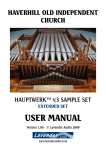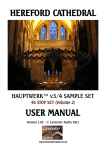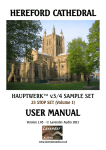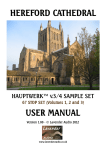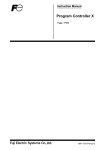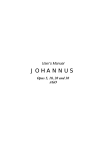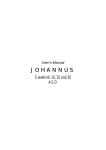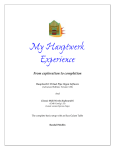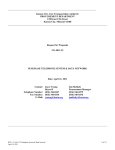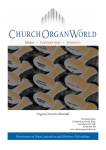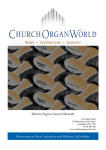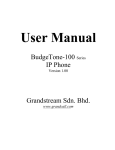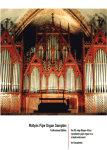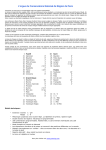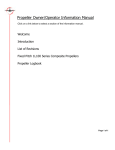Download Haverhill OIC MiniSet User Manual
Transcript
HAVERHILL OLD INDEPENDENT CHURCH HAUPTWERK™ v.3 SAMPLE SET USER MANUAL Version 1.00 - © Lavender Audio 2008 www.lavenderaudio.co.uk Thank you for purchasing this sample set. Please take a little time to read this manual to familiarise yourself with the various features it offers. NB. At the time of writing, only Hauptwerk version 3.10 upwards is supported. 1. Installation Please use Hauptwerk's component installer to ensure proper installation of this sample set. Start Hauptwerk and insert DVD1 into your DVD drive. In Hauptwerk, choose File | Install organ, sample set, temperament or impulse response ... and then navigate to your DVD drive to find the installation package (it's called HaverhillOIC-Part1). Once Hauptwerk has analysed the package you will be presented with the sample set licence which you will need to accept. After a while, the following screen is presented. You will notice that three organs are available to be installed - these are as follows ... Haverhill Old Independent Church This is the standard full organ designed for a display resolution of 1280 x 1024. Haverhill Old Independent Church Low Screen Resolution This is identical to the organ above apart from the fact that it is designed for a display of 1024 x 768. Haverhill Old Independent Church Bonus Mini Set This is the same organ as that provided for the separately available Haverhill MiniSet and is included here by way of a bonus. It can be installed if you wish, but it is not essential for the full set to function. Note that this organ doesn't install any extra samples - it makes use of those that are installed for the full set. Ensure that the Selected installation action for the [Data] item and for at least one of the [Organ] items is set to Install and then click OK. Installation should then proceed and the whole process may take many minutes to complete, depending on the speed of your computer. Once DVD1 has installed, remove it and insert DVD2 into your DVD drive. Repeat the process described above, installing HaverhillOIC-Part2 and noting that for DVD2 there is just the [Data] item to install. Assuming this is successful, the organ is now ready to load for the first time. Further information relating to this can be found in section 3. NB. Use of this sample set requires an update to your Hauptwerk dongle. You should have received this update by the time the DVD has arrived. If not, please contact Lavender Audio. 2. Specifications and background information The following information is provided as background to the creation of this sample set. It is by no means required reading but may help when considering the options available as the organ is loaded for the first time as well as helping with the various organ specific settings that Hauptwerk provides. The Haverhill Old Independent Church organ was recorded using the ORTF mic technique. This was felt to give the optimum balance of direct and reverberated sound whilst maintaining a good stereo image. The organ was recorded from a distance of approximately 4m from the front pipes. All samples are presented at a resolution of 24 bits and a sample rate of 48 kHz. Multiple releases were recorded, which add greatly to the realism of the sample set. All pipes have a release recorded for both staccato and sustained notes and a third set of releases were recorded for the Swell chorus reeds (not Oboe) and for all Great and Pedal stops (including the Trumpet en Chamade). These releases are for notes held for a duration between staccato and sustained (portato - typically 200 to 500 mS, depending on pitch). Some of the pedal notes have a total of 4 releases. Despite the relatively modest acoustic of around 1.5 seconds, this extra layer adds noticeably to the realism. It was found that for the softer stops a portato release made no difference to the overall sound. Please note that the multiple releases are handled automatically by Hauptwerk and that no special hardware is necessary. Each sample was sustained for an average of 6 seconds and each has been programmed to have either 3 or 4 loops. Having more than one loop imparts some life to the sound and makes long sustained notes sound more realistic. Up to 16 tremulant samples were taken for each Choir and Swell stop and these were processed using a special tool kindly provided by Crumhorn Labs. A limiting factor to the realism of the tremulant model is that the releases are not modulated in any way, so in effect a tremmed sustain has a non-tremmed reverberation. However, the relatively short reverb time of the building tends to minimise this problem. Likewise a large number of Choir and Swell samples were analysed for the level and harmonic differences between the swell box being open and shut and the results of this used to programme accurately Hauptwerk's swell models. Both the tremulant and swell parameters can be further adjusted by using the voicing tools (Advanced edition only). The organ is tuned to equal temperament at approximately A=450 Hz. All of the samples have been left at their recorded pitch with only the most out of tune being repitched from within the organ definition file. As a result, the normal tuning errors that are found in even the best regulated organs are present here and therefore contribute to the overall realism of the organ. However, it may be considered necessary to use the organ at standard concert pitch (A=440). This is possible and the organ definition file has been carefully programmed to produce appropriate randomised tuning errors when not using the original organ tuning (the strength of these tuning errors can be adjusted within Hauptwerk or even disabled completely so the organ plays in perfect equal temperament). The most realistic sound, though, will be when the original organ tuning is selected. Note that adjusting the random tuning errors has no effect in original organ tuning mode (NB this is only true for Hauptwerk v3.11 and later). 3. System requirements and loading the organ for the first time Although the organ has 40 speaking stops, computer requirements aren't too onerous by today's standards. This is largely due to the relatively short reverberation time, which means that polyphony (and therefore processor load) and memory requirements are less than those of similar sized organs in more resonant buildings. The sample set was developed on a PC consisting of an Intel Core 2 Duo E6420 processor with 8 GB of system memory running Windows Vista 64 bit and this platform has proven more than adequate to run this organ with all realism features enabled. The following table gives very approximate figures for the amount of RAM (memory) the organ requires with various different loading options set. None of these figures take into account the RAM needed by the operating system or Hauptwerk itself. Where no figure is given, that particular loading option (although valid) hasn't been tested, generally because it wouldn't make sense to use it. Of course, not all ranks need to have the same settings. 24 bit 20 bit 16 bit 14 bit Uncompressed ~ 8000 MB n 4210 MB n Lossless compression 4890 MB 4350 MB 2830 MB n Single loops and compression n 3825 MB 2190 MB 2030 MB Single loops and releases with compression n n n 1680 MB To achieve best results, the organ should be loaded at 24 bits resolution, no memory compression and with all realism features enabled. If your system doesn't have sufficient memory to allow this, then it is recommended to try the following in order until the set loads reliably (it is wise to allow for a small amount of unused memory to keep the operating system happy !) ¨ Use lossless memory compression (audio quality is unaffected although polyphony is reduced by approximately 15%) ¨ Load some or all samples at 20 bit resolution ¨ Load some or all samples at 16 bit resolution. ¨ Only load a single loop on some or all samples. ¨ Load some or all samples at 14 bit resolution ¨ Only load single releases for some or all samples It is possible to go a fair way down this list with little obvious loss of realism or quality – however the last two options should both be avoided if at all possible. Loading single loops means that very approximately only half of the sustain section of each sample will be loaded, leading to a useful saving in memory space. You can also reduce the load on your computer's processor by disabling the wind model (not appropriate in the US), disabling real time harmonic shaping and disabling interpolation, all of which will affect the realism of the organ. The first time the organ is loaded the sample cache is built. This takes a considerable time – maybe 5 minutes or more. However, subsequent loads are much quicker. Once the organ is loaded, you can use Hauptwerk to connect the keyboards, stops, pistons and swell pedals of your MIDI setup as necessary. Default settings for all of the sample set's inputs have been carefully specified, so this process should only take a minimum of time. If your MIDI rig has only one or two manuals, then it is well worth using Hauptwerk's redirectable keyboard feature to help access all three manuals. 4. Haverhill OIC Sample Set Screens As described earlier, two organ definition files (ODFs) are provided to cater for two different screen resolutions. The standard ODF needs a display resolution of 1280 x 1024 to load, whilst the ODF called HaverhillOldIndependentChurch–LowScreenResolution is designed to run on the Hauptwerk minimum screen resolution of 1024 x 768. Please note that otherwise both ODFs are identical – there is no difference in sound quality or features between the two and they share a common sample cache. Either may be loaded as appropriate with (for example) the same stored combination files being accessible for each. The Console screen is for the purist, as it offers the most realistic view of the instrument without the extra features that are seen on the other pages. All of the keys, pedals and stops respond to the mouse as well as providing a visual indication of remote control via MIDI. Although much of the display should be intuitive, here are a few pointers for those not familiar with this sort of organ. The Great is the middle manual, with Choir below and the Swell above (unlike some European organs where the equivalent of the Great is at the bottom). Both Choir and Swell are enclosed, being controlled by the left and right pedals respectively. The specification of the virtual organ is nearly identical to the original instrument. The only addition is the Great Harmonic Flute, which is unified with the Nazard. When built, the organ had a Harmonic Flute at 4 foot pitch on the Great – this was transposed to become a Nazard in the 1980's. The Hauptwerk sample set therefore offers the opportunity to use either stop ... or even both together, should you wish ! A special feature of many organs built by Binns is his patent combination action. In the days of multimemory solid state combination pistons, it's easy to forget how revolutionary this facility must have been when it first appeared, not least as some organs of the time had to be partially dismantled to change the combination of stops that were drawn when a piston was pressed. The Haverhill organ has four combination pedals that act on the Swell and four that act on the Great and Pedal together. In each case, the fourth combination is fixed with other three being adjustable at the console. Setting a combination pedal is straight forward – simply select the stops you wish to assign to a pedal and then draw the relevant setter drawstop (eg Great No.1). As the setter drawstop is released it goes back in and sets the appropriate combination pedal. This operation is precisely modeled in the sample set. The combination pedals to the left control the Swell and those to the right control the Great and Pedal (in each case pedals 1 to 4 go left to right). The combination pedal to the far left is simply a reversible acting on the Great to Pedal coupler. The Stops + Pistons page offers a convenient way to control the organ from a single screen. It also offers some extra features that you won't find on the real instrument. There are 6 pistons for each division and 20 General pistons. They are all fully programmable – select the stops you wish to assign to a piston and then click on the setter piston (labelled 'S') followed by the piston you wish to assign the combination of stops. It's important then to click on the setter again to switch it off after you have finished programming the pistons. The 'C' piston is a general cancel. Incidentally, the extra pistons on this page are completely separate from the Binns combination pedals. This means that there are effectively 10 pistons to the Great, Swell and Pedal. For the purposes of mapping external switches to pistons, the default is to map the Binns combinations to pistons 7 to 10. Of course, this can be altered should you wish. It is also possible to programme the Binns pistons using the setter piston should that prove to be more convenient. These controls allow you to couple the piston action. For example, if the “Great and Pedal Combs Coupled” is enabled, then pressing a Great piston will also operate the corresponding Pedal piston (and vice versa). Neither combination coupler is affected by any piston, divisional or general. Basscouplers offer a way of playing the pedal organ from the manuals. This can be useful in various circumstances, not least if your virtual organ lacks a pedalboard ! The basscoupler is intelligent in that only the lowest manual note sounds on the pedalboard, meaning that only one note is played at a time giving a far more musical result than a simple “Pedal to Manual” coupler. The state of the basscouplers is stored and recalled with the general pistons only – the divisional pistons have no effect. The next two pages (LH and RH jamb) spread the contents of the Stops + Pistons page over two pages and are of use if you have a multi-monitor setup. The layout of the stops doesn't exactly conform to the real instrument, but is approximately correct. The stops and couplers in each screen are all linked, so that if you operate a particular stop in (for example) the Console screen, it's counterpart in the Stops + Pistons and appropriate Jamb screen will also change. The Settings page allows a quick and convenient way of enabling or disabling stop action noise, key action noise and blower noise as well as setting the relevant noise levels. To set the volume level, simply click on the appropriate LED bar graph and the volume will adjust to the point where you clicked. The calibration of the bar graphs is in decibels. Key action noise on the real organ is quite quiet, the exception being the bottom octave of the Swell which is noticeably louder. It was generally not possible to remove this totally from these samples (although enough has been removed to make the effect of playing this part of the Swell with several stops drawn acceptable), so even with the key action noise switched off, note on and off noise will still be noticeable to an extent. Both swell pedals are perfectly silent in operation, hence there is no noise associated with their operation. There is also the facility to set the volume of the Trumpet en Chamade. When this organ was sampled, the decision was taken to sample the Trumpet en Chamade from a greater distance than that used for all other ranks. The reason for this is that this stop is absolutely devastating at the console as well as sounding a little harsh. Once further back in the church the natural acoustic gives the stop a much rounder and more musical sound – of course, the stop was voiced to sound good in the church rather than at the console, so it seemed to make sense to take advantage of this when sampling. This then raises the question of what volume level to use for the stop, hence the facility to give that decision to the end user. Please note that Hauptwerk Advanced Edition has comprehensive voicing facilities and this is highly recommended if you wish to make changes to the volume, tone or tuning of other stops. 5. In use ... setting this organ in historical context and some thoughts on registration and repertoire. The English romantic organ was at its height in the late 19th and early 20th centuries. The trend had been to move away from the classically conceived organs of the 18th and early 19th centuries to organs which employed increasing wind pressures and a greater variety of flue and reed colours using newly designed pipework. The organ was increasingly being seen as an orchestra as imitative stops became more realistic and the fashion of the day was for an overall smooth and round tone. Traditional chorus structures were displaced by a heavy emphasis on unison tone whilst such upperwork that remained was being voiced relatively quietly. Mixtures tended to be pitched quite low with some quite unsubtle breaks which didn't always help the performance of polyphonic music. Henry Willis commonly employed a tierce in his mixtures and Arthur Harrison's Great mixtures often included a flattened 21st rank as well. Some builders, notably Robert Hope-Jones almost totally abandoned anything above a 4 foot rank, even in large instruments (eg. Worcester Cathedral). In contrast, builders such as T.C.Lewis and J.J.Binns kept truer to the organ's classical traditions, maintaining a proper chorus in many of their instruments. Thus the organ at Haverhill has a full Great diapason chorus from 16 foot to a “clean” mixture – likewise the Swell (the Tierce rank in the Swell mixture was only introduced in the 1992 rebuild). Of course, the prevailing fashion meant that the Great Open Diapason is typically big and round in tone and quite unlike anything that might be found in continental Europe. The Great flutes are also big in sound and very much lacking in upper harmonics – again typical for the period. This was an era when the Great organ was just that – stops here are much bigger in scale than anything other than the swell reeds. Full swell is typically English being reed rather than flue dominated. The rest of the swell is also as might be expected, with very English sounding soft strings and a family of four flutes. The Choir organ is almost a solo organ with at least four imitative stops (the Choir Mixture and Trumpet en Chamade were also added in 1992). The Haverhill organ is suited to a wide variety of repertoire. English music obviously works well, with much of the output of SS Wesley, Alfred Hollins, Charles Stanford, Hubert Parry, Percy Whitlock and Herbert Howells being a good fit. However, the Preludes and Fugues of Bach and Buxtehude can sound good and although the tone of the organ is quite some way from being a Cavaille-Coll, the French romantic school can sound very effective. The German romantic era is also worth exploring – Mendelssohn generally sounds good and many of the colours called for by Karg-Elert and Reger are there, although it's easy for some of Reger's music to sound a little “muddy” on an English romantic organ. When registering, bear in mind that the octave couplers can be used to great effect – the full compass of 61 notes helps to lessen the problem of running out of notes at the top. The soft swell strings with octave coupler are very pleasant and at the other end of the scale, adding the Swell to Great octave coupler is very effective in full combinations. In the build up of the swell, the Oboe stop would typically be drawn quite early, usually before the mixture. A useful mini full swell can be obtained by drawing 8, 4 and 2 foot flues, the Mixture, Oboe and Contra Fagotto. Returning to the Great, bear in mind that the Viola is really a small open diapason and therefore quite usable with the Principal and Fifteenth. In addition, the combination of Hohl Flute, Principal and Fifteenth works very nicely in contrapuntal music. Although the Nazard may seem a little out of place, it's a handy stop to add a little colour, especially as part of a solo combination. Try the Double Open, Hohl Flute and Nazard played up an octave as a solo. Unlikely as it may sound, just the Viola and Nazard together can be used against Swell 8 and 4 in a Bach chorale prelude – not necessarily an authentic sound, but it works ! For both the French and German romantic school, it's best to avoid too much heavy 8 foot tone. The Choir Orchestral Oboe sounds quite French and that stop along with the Choir flutes and Viol di Gamba can be good for Cesar Franck. The Choir Concert Flute is a lovely stop – try coupling it to the Swell strings and then using it as a solo against the strings. The swell is a good starting point for lighter music – try the Stop Diapason, Viol d'Orchestre, Mixture and Oboe with the octave coupler and tremulant for a more than passable theatre organ sound. All of the above is very much intended as a starting point to encourage exploration of the organ and discover combinations that work for you. There is also no reason why external reverb should not be added to place the organ into a bigger acoustic. 6. Acknowledgements Finally, my thanks go to the following people ... Brian Swallow, the organist at Haverhill Old Independent Church for his great support and enthusiasm in getting this project off the ground. Karen Knight, the minister of the church and the lay elders and congregation for their hospitality and for agreeing to allow the sample set to be made publicly available. Peter de Vile, who tunes and maintains the organ to a very high standard. Martin Dyde and Brett Milan for their help and support in bringing the sample set to fruition. Appendix – Licence Agreement 1. The sample set may be used indefinitely by the licensee on any computing equipment owned by them in any form of private or public installation. 2. Copyright in the original samples, images and organ definition files is retained by Lavender Audio. 3. Copyright in any musical performance using these samples is vested solely in the licensee. A musical performance is defined as one in which the samples are combined in such a fashion that no individual samples could be re-used by a third party. 4. These samples are licensed only for use in connection with software issued by Crumhorn Labs or their successors. Note that the individual samples (but not the organ definition files) are encrypted to ensure this and a dongle update is required before the samples may be used. 5. Organ definition files and custom organ definition files may be freely edited for personal or public use by the licensee but not distributed to any third party unless specifically authorised by Lavender Audio. 6. These samples may be freely combined with samples from other sample set producers to form composite organs defined by standard or custom organ definitions only where this is specifically permitted by the third party sample set licence(s). Any composite organ so created must only be for personal use and not transmitted in any form to any third party. 7. Although any form of private or public performance is fully licensed, permission must be obtained from the Haverhill Old Independent Church (via Lavender Audio) for any recording using these samples that has a planned commercial release. 8. This licence is not transferable. Samples and organ definition files may not be resold or given to any third party without prior permission from Lavender Audio. © David Butcher, October 2008








